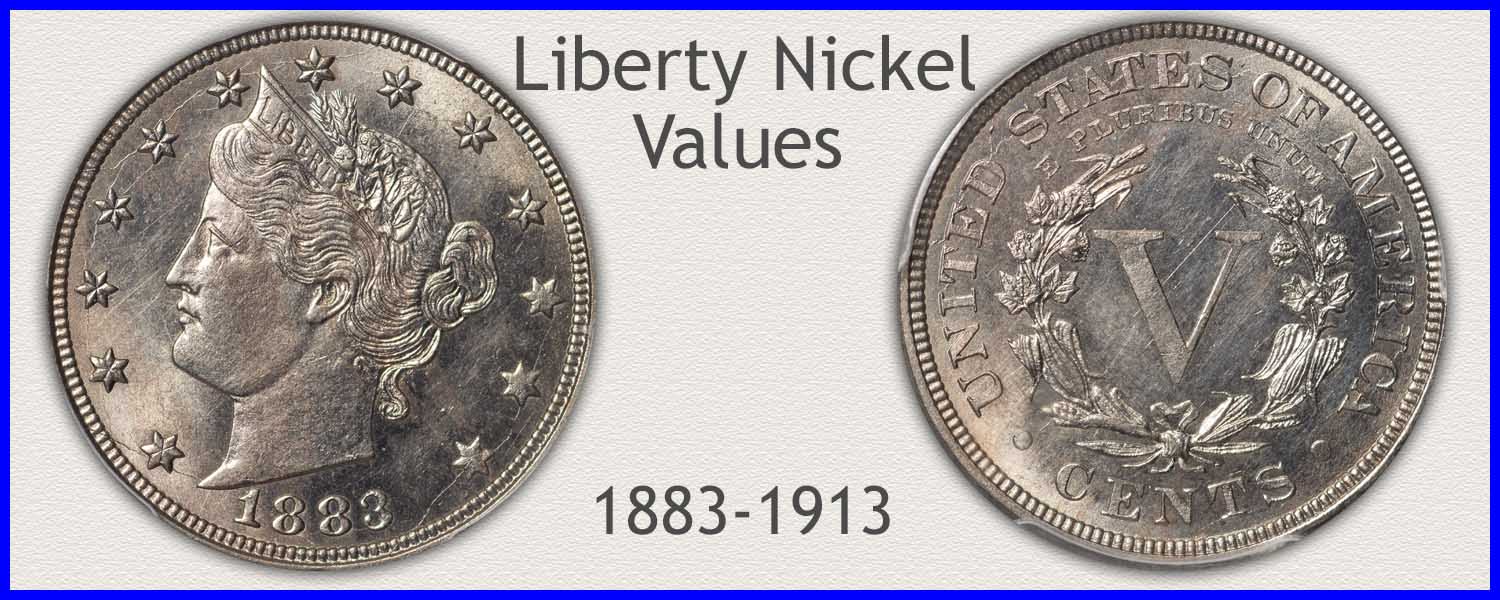Coin Values Moving with Precious Metals: Up-Dated 11/10/2025: Gold $4070 | Silver $49.42
1901 Nickel Value
A first step in determining 1901 nickel value is confirm the series and date. From an earlier century, Liberty nickels are an old, obsolete U.S. coin series. The value chart shows those from the 1880s are becoming scarce. Recognize all the important features of a coin, including its condition. Steps to value begin with your coin's date.
Next, continue with a review of their potential special qualities. Many factors contribute to their collector appeal. Coins often exhibit pleasing qualities in subtle ways.
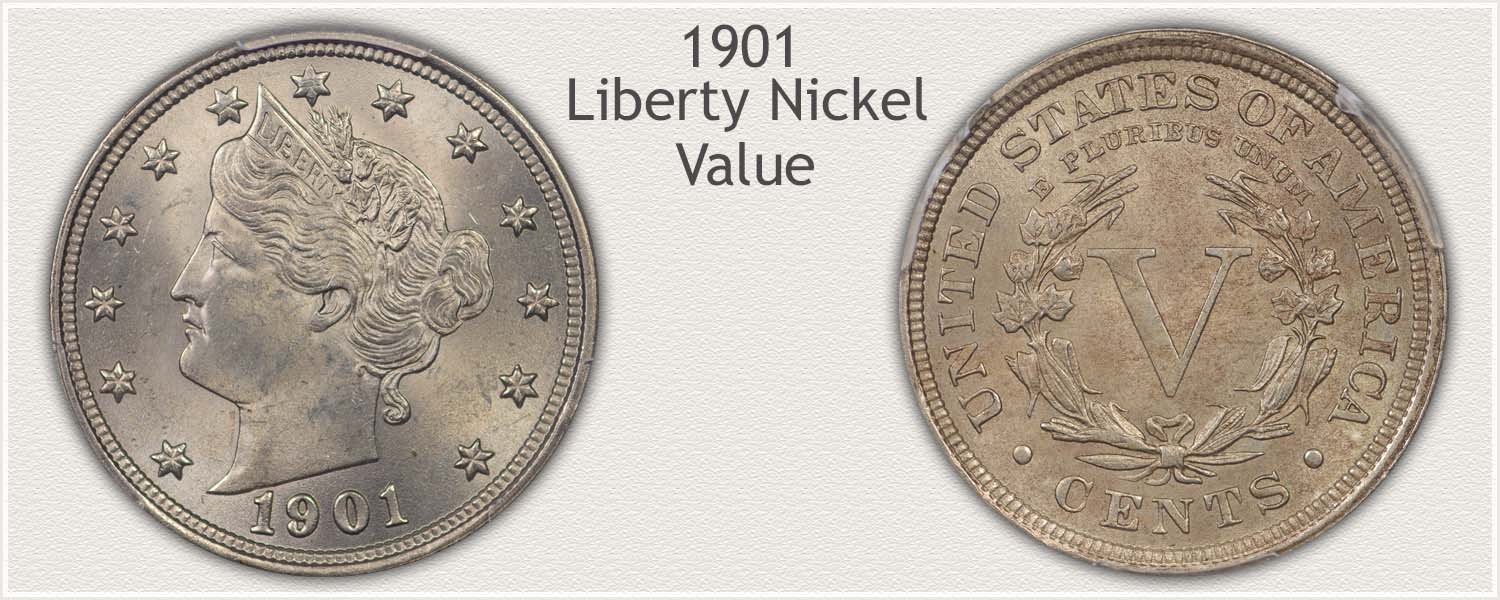
Steps Leading to Value:
- Step 1: Date Identified - To organize a collection, it is important to record the nickel's date at the time of your first inspection.
- Step 2: Grading Condition - Assign a grade to the coin by comparing to images of different conditions.
- Step 3: Special Qualities - A few factors contribute to the 1901 date's strong values. Primarily, scarcity and its condition.
| 1901 Nickel Value | ||||
|---|---|---|---|---|
| Condition of Coin | ||||
| Date | Good | Fine | Extremely Fine |
Mint State |
| Liberty Nickel Value Updated | 2025 | |||
| 1901 | $1.80 | $5.05 | $24 | $67 |
Market values listed above are a range of wholesale values. Use as a starting point when selling these Liberty nickels.
Step 1: Dates are Accurately Recorded as Part of Selling
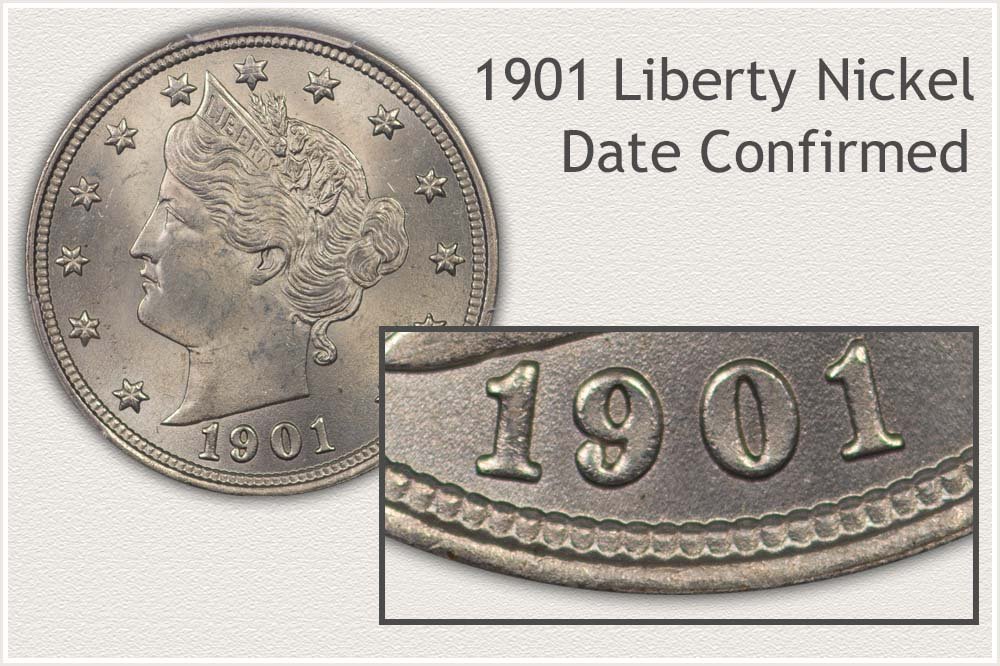
An accurate value of these 1901 nickels is important when it is time to sell. Minted at the start of a new century, these are a popular date with collectors. Liberty nickels enjoy a steady demand within the market. Records show an ample mintage of over 26.4 million, providing many today to meet the demand.
Two factors are key to a description of the coin, its date and condition. Starting the value process is always with an accurate reading of the date, and notation of the series. 1901 is a date minted during the Liberty design series and referred to in the hobby as Liberty nickels. Always double check the date. Step 2 following is assessing condition and defining a grade.
Step 2: | Judge Condition and Recognize a Premium Grade
1901 Nickel Value and a Range of Conditions
A "grade" represents a definition of a coin's condition. Specific stages of wear on design features place the condition into categories. Grades, for example, Fine Grade, are part of the description of a coin along with the date and mint of issue. Within the coin market, collectors and dealers have an initial idea of a coin's condition based on its grade.
A grading process starts with comparing a coin to images of specific grades. Then verifying quality details as described in the grade's description. Find a close match to an image below and confirm a narrow grade range when judging specific details.
Mint State Grade
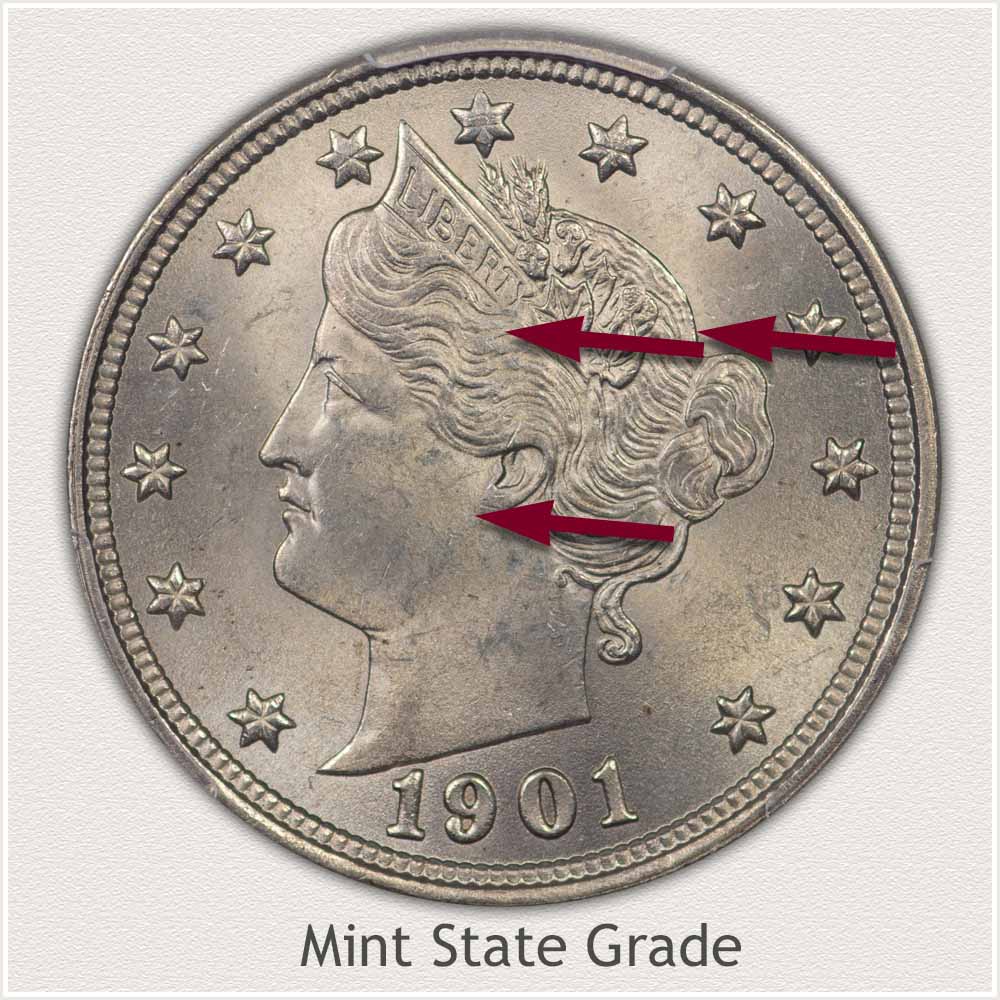
Mint State: The Mint State grading standard centers on the bust of Liberty and its many details. A strict requirement is no visible signs of wear are present. First examine the small details found within the hair strands. Next, move on to Liberty's cheek and neck region.
Liberty's cheek is one of the first places to confirm there is no smoothing or dulling. Metal in this area is high in profile exposed and unprotected. A coin's shine and delicate luster, is a fine texture on the metal that reflects light when the surface is not worn. Her cheeks are uniform in texture on both the high contours and low recesses, when viewed closely. The lower line under the jaw and the metal of her cheek both have a similar texture and shine.
Full details within Liberty's hair give the grade a high-quality appearance. The depth of recesses highlights many fine strands. Numerous contours on the high relief areas of the hair strands are fully rounded. Any wear is visible as a dull tone and small flattened areas along the tops of high reliefs. Just in front of the tie at the back of her head, the small hair details is an area to judge for wear.
Extremely Fine Grade
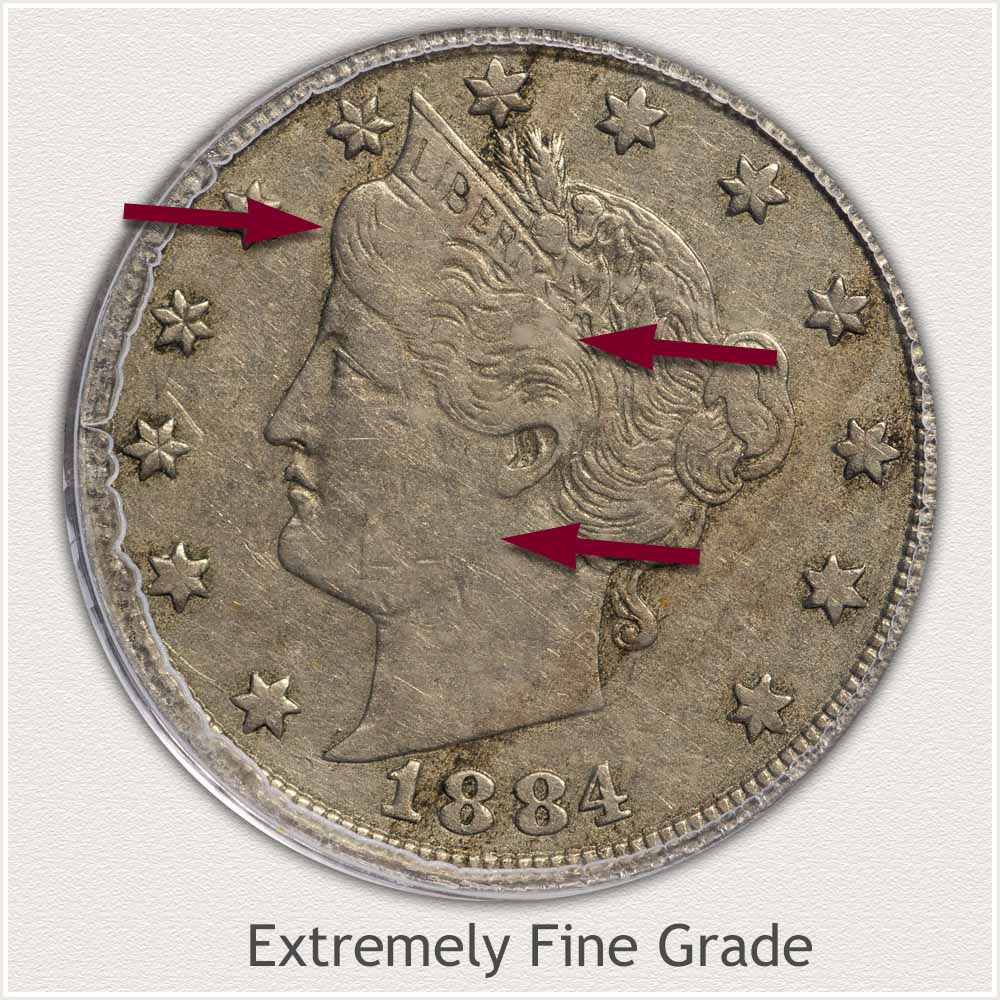
Extremely Fine: Liberty nickels in the Extremely Fine grade display a nicely crisp condition. There is only very slight signs of circulation wear. One defining feature of the grade is light wear restricted to high points of the design only. These high quality nickels immediately impress with their sharp, well defined details. A close examination of the fine hair strands, a major feature of the portrait of Liberty, is the first step in determining the degree and severity of wear.
Notice an area of missing hair strands above Liberty's eye. Deep recesses within the hair fade along the forehead. Hair detail then resumes towards her ear. There is a narrow strip of flatness connecting her hairline at the forehead to the headband. To maintain the grade, sharp hair details are visible on either side of the flattened hair wave area. Any flatness within her hair is separate from others and only minor.
Second noticeable feature: the metal no longer has a gleaming luster. Liberty's neck and cheek are slightly smooth. Lost is the texture when first minted. Reference the Mint State image above to help recognize the difference. Overall, the surface of the nickel now has a soft gray tone to the metal. Many fine details display a crisp appearance above the headband. These details include wheat grains and cotton leaves. The nickel imaged has avoided any deep nicks, giving it a visual plus.
Fine Grade
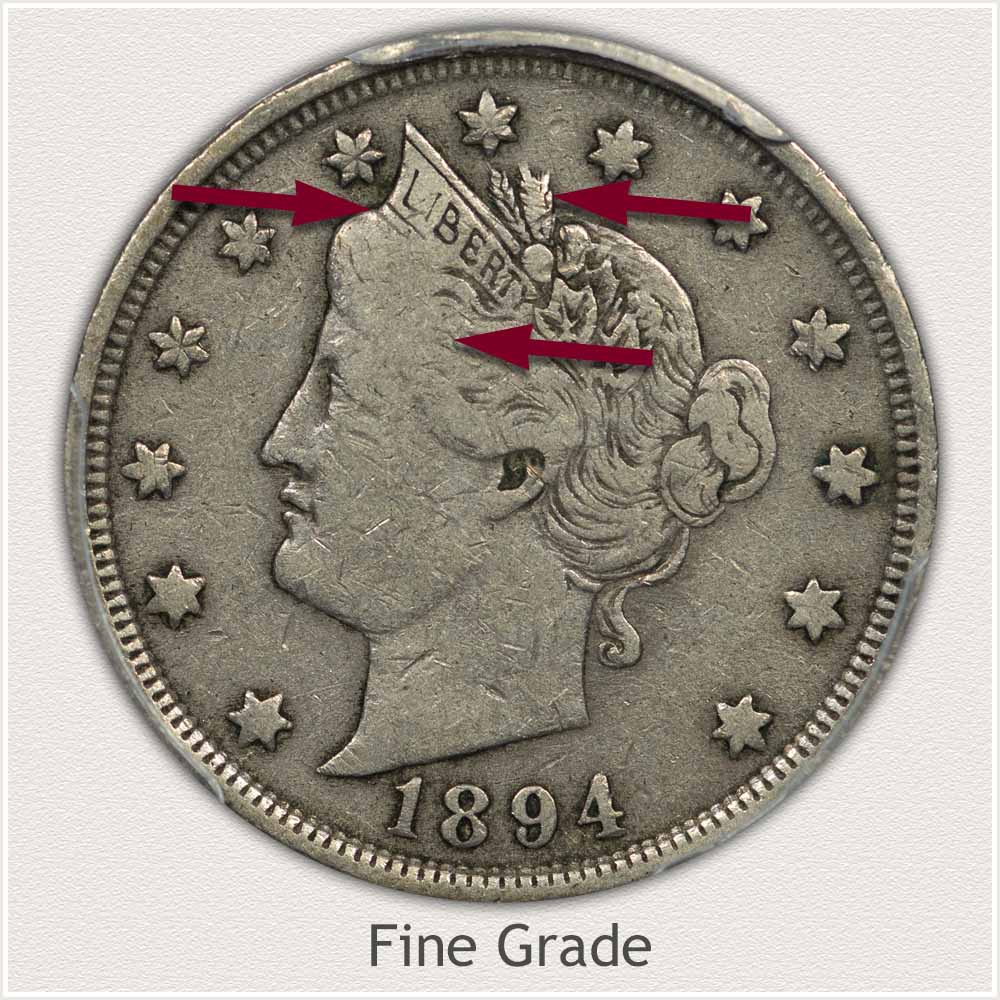
Fine Grade: Defining the grade, large areas visibly worn contrast with numerous details. When grading Liberty nickels consider the amount of visible detail. There is a balance with the degree of missing detail.
A complete lettering of "Liberty" within the headband is a crucial feature to confirm. The loss of defining hair strands over Liberty's eye also contributes to the judgment of condition. However, the lettering across the headband is readable. Clear letters place the coin in a high quality condition.
There are also distinct wheat grains, cotton leaves, and cotton bolls found towards the top of Liberty's head. These visible features are all showing signs of just slight to moderate wear. A coin free of large nicks and having a pleasing silver-gray color is of high quality for its grade.
Good Grade
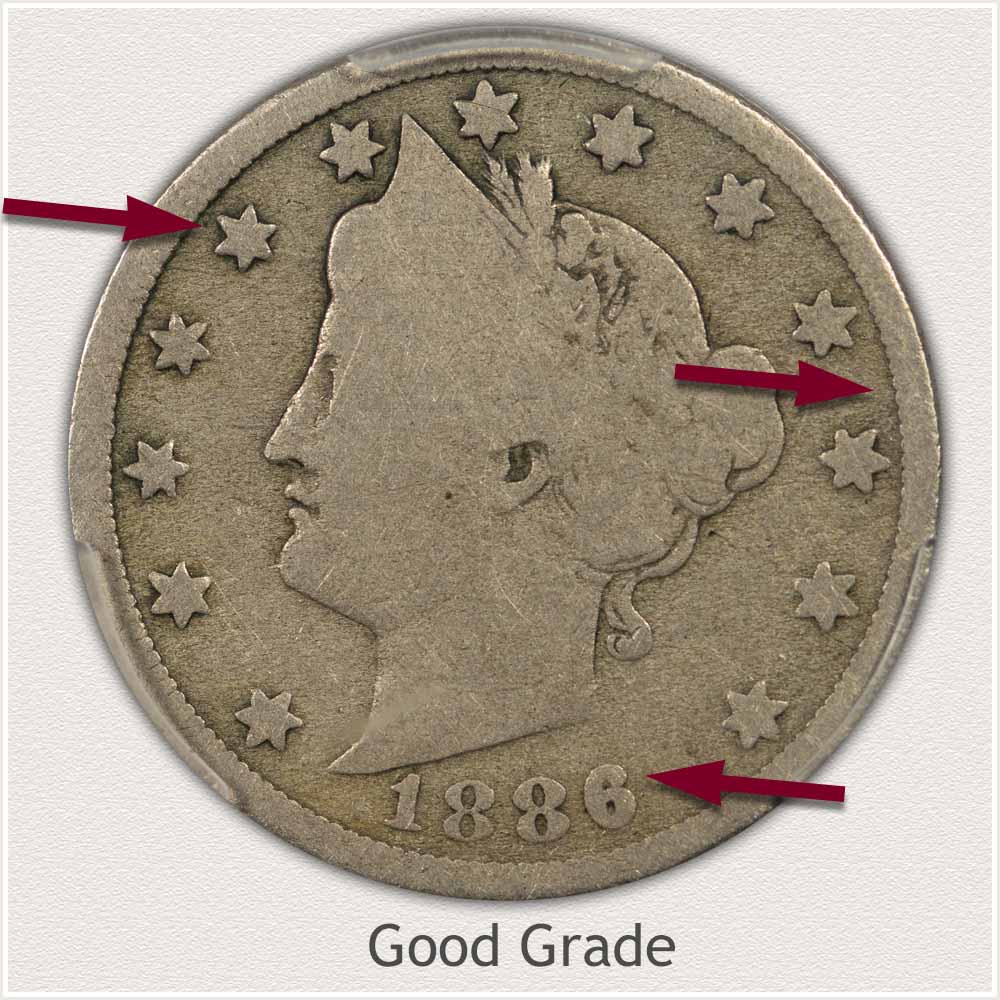
Good Grade: This Liberty nickel's major features are now merely outlines due to extensive wear. Liberty's portrait, the focal point of the coin, has lost most of its original detail. Upon close inspection, the portrait's defining edges are all clearly intact. Her outline remains bold, and well raised above the coin's lower field. This helps define and identify the grade level. As soon as her outline begins to fade into the field, collectible status also fades as well.
A nice Good grade Liberty nickel displays all thirteen stars visible and with full outlines. Also, a complete inner edge of the rim, enhances the strong outline of Liberty. Add the clear date as displayed in the example, and many collectors find this a pleasing condition to collect.
How to Video: Grading Liberty Nickels
The Liberty Nickel grading video adds insight into the process of grading. Descriptions of both the obverse and reverse inspect the subtle qualities of the grade. Judging the complete coin further narrows condition when grading these coins.
Grading Liberty Nickels | Visual Grading Guides
Step 3: | Special Qualities | Identify Solid and Complete Quality
No Questions as to Collectible Quality 1901 Nickel
An interesting situation exists in the Liberty nickel series. Strike quality sometimes differs when comparing the obverse to the reverse. The reverse design is very "busy" in comparison to the obverse. On the reverse, many details spread over the entire coin. In the center a wreath features leaves, cotton, and corn. Moving outward, a legend follows the entire rim. Just below, sits a lightly impressed motto between the lettering and wreath. Many design elements fill the reverse.
A difference in striking clarity plus wear patterns generally causes the reverse of these Liberty nickels to diminish in quality faster than the obverse.
When judging condition, the obverse is the primary side, and the reverse is the secondary. Grades define condition as one grade, it reflects both sides of the coin. Consider this when judging coins in heavily worn condition.
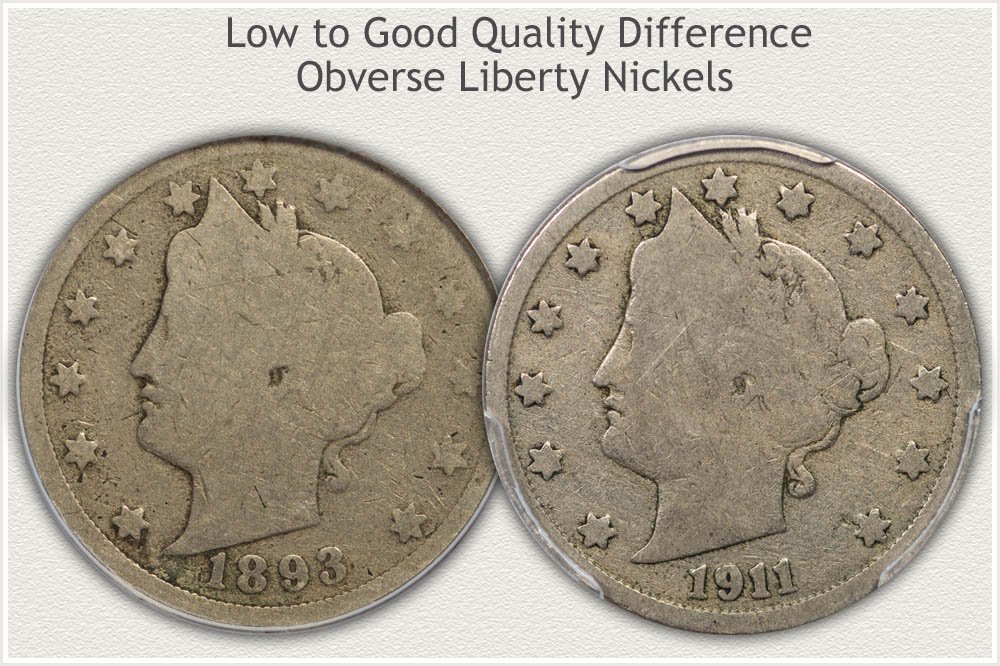 Visible Quality Difference on Obverse of Liberty Nickels
Visible Quality Difference on Obverse of Liberty Nickels
Initial collectible status is reserved for coins meeting the Good grade category. Important to the obverse is a full outline to Liberty, stars, date, and rim. Remaining features are complete, with no fading into the fields or blending into the rim. Notice the difference between the two examples when applying these standards.
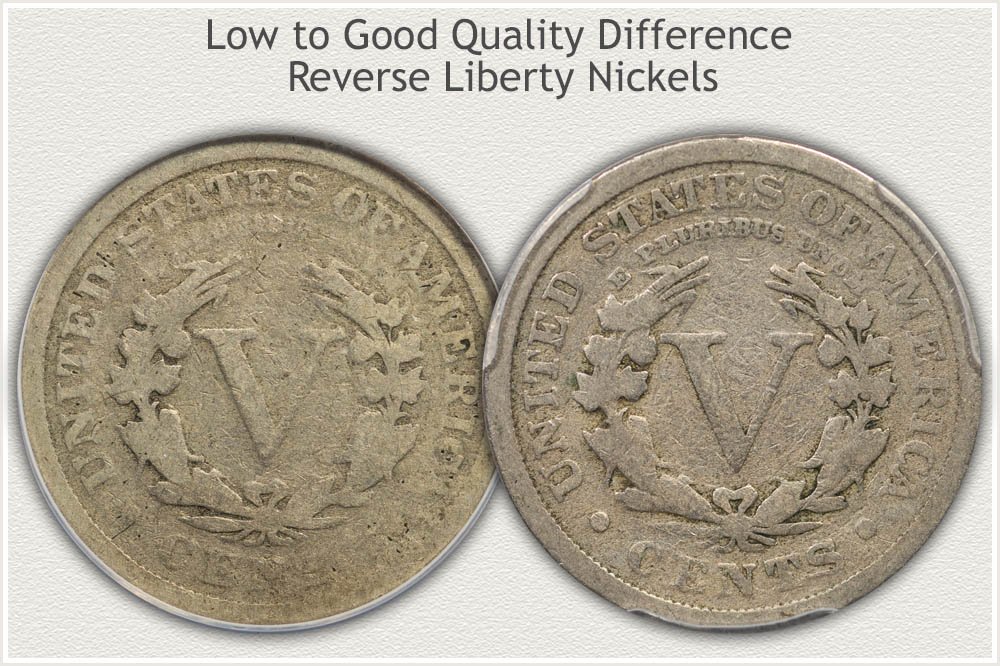 Visible Quality Difference on Reverse of Liberty Nickels
Visible Quality Difference on Reverse of Liberty Nickels
A challenge is often presented to collectors seeking a coin with a high quality reverse. Many examples that show a strong obverse lack completeness with areas of fading on the reverse. The coin on the right meets the standards of full outlines, no missing major features, and all elements are separate from the rim. The coin on the left does display elements of boldness. However, looking closely, the motto "E Pluribus Unum" (out of many, one) is indistinct. Also, and importantly, the "S" in CENTS is missing and blending with the rim. Missing key elements and a faded rim fall below the Good grade requirements. The left side coin is just missing a significant quality requirement.
Completeness and bold features on both sides of a Liberty nickel indicate solid quality and a special coin to collectors and the coin market. These nickels are at the beginning of the collectible scale. When displaying a nice balance of condition on both sides are the exception and in demand.
References
U.S. Mint. 1902 U.S. Mint Annual Report.
https://nnp.wustl.edu/library/book/321
U.S. Mint. Catalogue of Coins of the United States.
https://nnp.wustl.edu/library/book/554591
Coin Values | CoinStudy Articles
Date by Date
In Depth Liberty Nickel Values
1883 to 1912
The Value of V Nickels | The Liberty Series Covering all Dates and Mints
Complete value chart of the Liberty Series of nickels. From the common to scarce, and rare. Follow a defined method to determine worth.
Popular Coin Series | Liberty Nickels
Popularity is the starting base for coin values. Demand from collectors and dealers determines how much these Liberty nickels are worth. Listings of all coin series by their popularity give insight into the strength of demand.
Rare nickels are found in all the different design series. Five cent nickels, first introduced in 1866 with the Shield design, are an example of a series with many scarce dates. Highlights include the Liberty, Buffalo, and Jefferson dates and mints becoming difficult to find.
Selling Coins | A Defined Process
Many of these vintage nickels are potentially very valuable. The Shield and Liberty series are considered premium coins. Follow a defined process when time to sell. Use the resources to identify an accurate worth and listings of dealers to contact to receive market value.
★Coin Values Discovery finds 1901 Nickel Value and...
A step-by-step process discovers all U.S. coin values. Images identify the different series of coins covering all denominations from cents through gold coinage. Each is further detailed with important elements and features key to a complete and accurate worth. A box of old coins has potential.
